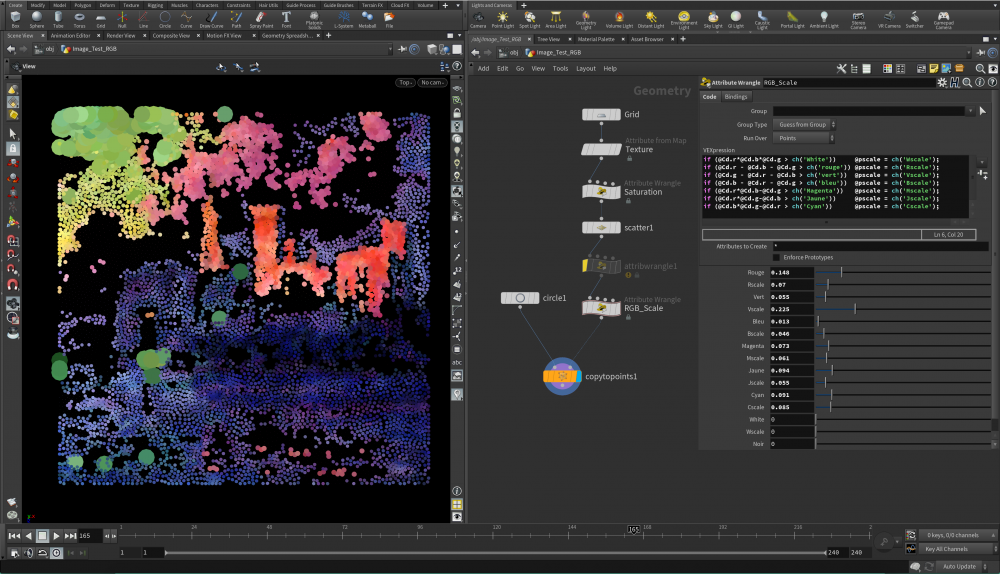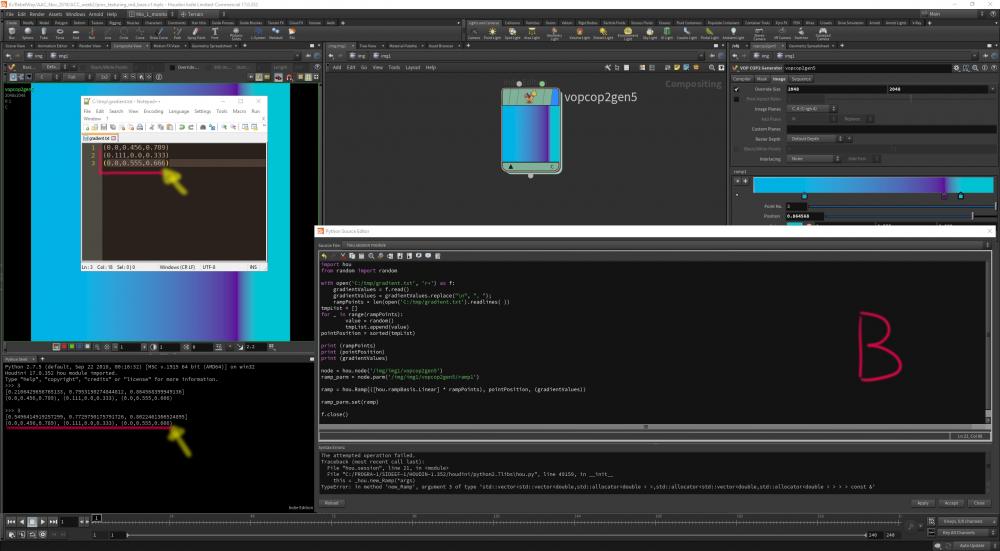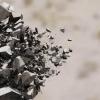Search the Community
Showing results for tags 'rgb'.
-
Hello, I am pretty sure you will find a solution to my problem in seconds, but as I don't know and find much about this problem I find myself asking here. I have a very basic setup : Some sphere copy with a scatter as input. I took care of the fact that they are not intersecting at the beginning. I moved them thanks to VDBadvectPoints and a turbulence noise. So I need them to keep moving. Now what I try to acheive is prevent them from get into each other, but still moving, and keep as much as possible the initial movement (I don't want them to repulse each other or starting to create a messy simulation). Any idea ?
-
Hi everyone, I'm trying to select the color from a point cloud (in the geo context). Separate them to apply a different pscale attribute depending of the color value. With VEX , it's easy to select separte RGB and CMY values with addition and subtraction : Red = @Cd.r - @Cd.b - @Cd.g Green = @Cd.g - @Cd.r - @Cd.b Blue = @Cd.b - @Cd.r - @Cd.g Cyan = @Cd.b*@Cd.g-@Cd.r Yellow = @Cd.r*@Cd.g-@Cd.b Magenta = @Cd.r*@Cd.b-@Cd.g My problem is that i lack a precise value to separate intermediate values, pastel colors, colors between two primary colors, etc ... How can i pick a special color to applied precisely my pscale value. Is it a good way ? Is there an other way to have a color picker ? a Keying function ? Hope this is clear, Regards,
-
hi, I'd like to start by saying that I'm only a couple of days into python and I'm aware the code might not be the most beautiful, but it seems to work, for the most part. I am simply reading a txt file with RGB value in each line, then I'm assigning to a ramp as many ramp points as there are lines with a sorted random position. so far so good, everything works.. the problem is that the script works only when I manually write each color, they definitely get assigned to the ramp, I can see it works because the position of the flags changes every time I execute the script. (image_A) but I get an error when I try to assign them with a variable that reads from the file, and the whole script fails, the position of the flags never changes when I get the error. (image_B) the weird thing is that I know that the numbers stored in my variable are correct because I can print them on the shell regardless if the script fails or not. hopefully there is some one that can help, this is the script that works: import hou from random import random with open('C:/tmp/gradient.txt', 'r+') as f: gradientValues = f.read() gradientValues = gradientValues.replace("\n", ", "); rampPoints = len(open('C:/tmp/gradient.txt').readlines( )) tmpList = [] for _ in range(rampPoints): value = random() tmpList.append(value) pointPosition = sorted(tmpList) print (rampPoints) print (pointPosition) print (gradientValues) node = hou.node('/img/img1/vopcop2gen5') ramp_parm = node.parm('/img/img1/vopcop2gen5/ramp1') ramp = hou.Ramp(([hou.rampBasis.Linear] * rampPoints), pointPosition, ((0.0,0.456,0.789), (0.111,0.0,0.333), (0.0,0.555,0.666))) ramp_parm.set(ramp) f.close() this is the one that fails: ramp = hou.Ramp(([hou.rampBasis.Linear] * rampPoints), pointPosition, (gradientValues)) and this is the error: The attempted operation failed. Traceback (most recent call last): File "hou.session", line 21, in <module> File "C:/PROGRA~1/SIDEEF~1/HOUDIN~1.352/houdini/python2.7libs\hou.py", line 49159, in __init__ this = _hou.new_Ramp(*args) TypeError: in method 'new_Ramp', argument 3 of type 'std::vector<std::vector<double,std::allocator<double > >,std::allocator<std::vector<double,std::allocator<double > > > > const &'
-
Hi, I would like to convert an rgb color value of an attribute at points to temperature (kelvin). I am wondering if anyone is aware of any algorithm related to that. cheers, C
-
Hey guys, I've been trying to solve one problem I have with RGB applying to voronoi pieces, which are driven by particles. So in the beginning I create a box and voronoi it, create centroid point for each piece and move the points to affect the movement of voronoi pieces with a copy node. Now, the effect I'm trying to achieve is that when the particle turns red, the particle stops moving, and the voronoi piece that the particle is driving stops as well (velocity becomes 0). The problem I have is, that if the particles are not moving (its just static voronoi cube) the switch to RGB works perfectly. But as soon as I add curl noise on particles or any movement, the RGB simulation messes up. You can see that in my .hip file when you go to - box_object1 - popnet1 and you visualise the "BROKEN_SIM" node (which makes the particle stop when they turn red). If you visualise CORRECT_SIM, everything works just fine. Could it be that the rest position takes the frame 1 position of voronoi and then messes up, because voronoi has moved? Does anyone have an idea what could I be missing? dropFreakingOut.hipnc
-
Hey guys, I'm trying to create an effect, where spheres move from the centre and after a certain frame, they all fall on the ground after each other. I've created pop net which drive the movement of spheres. I've tried to achieve the falling of spheres in two ways: 1., force and collision in popnet - works nice, but the rotation looks funny when colliding with the ground + I can't come up with a way, how to make the spheres fall after each other (so they don't just fall on the ground at the same time) 2., rigid body for spheres - I can't find a way how to mix the velocity from pop with rigid body. What I did was, that put a switch node and after a given frame - pop driven spheres are invisible and the RGB spheres become visible, but I suppose that is a very nooby way of doing it There is a visible difference between these two ways, because the popnet driven spheres fall down nicely and the fall looks more natural. With RGB spheres you can see when the movement is switched. Is there a way how to take the velocity form the popnetwork for each particle driving the sphere and blend it with the RGB simulation somehow? Or in other words, could I make the rigid body simulation of spheres make look like the one I created with the popnet? Sorry if there already is a topic explaining this problem, but I wasn't able to find it yet. Thank you RGB_POP.hipnc
-
Hey Guys, Does Anyone Know How To Transform From RGB to HPV? I Cant Find It Anywhere In The Menu And Its Driving Me Crazy. Thanks Again







